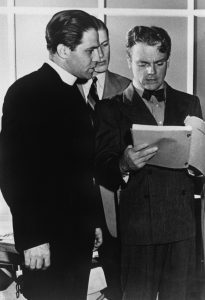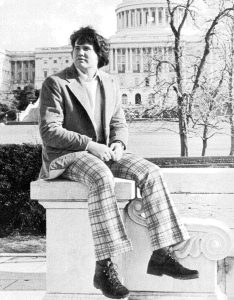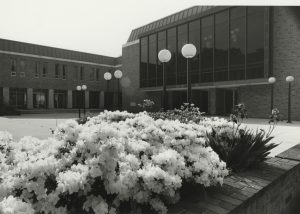
A few weeks ago I wrote a blog post on Bishop Fulton Sheen and his popularity in the mid-twentieth century as the TV show, Life is Worth Living, gained millions of viewers. Sheen was a well-known presence on the CUA campus from 1926 until 1950, after which he became a nationally known television expositor of the Catholic way of life.
There was another star on campus during these years, and in fact, beyond. About a decade younger than Sheen, Reverend Gilbert Vincent Ferrer Hartke, O.P., served as the founder of CUA’s theater program, and later, the Department of Speech and Drama in 1937. Hartke Theatre bears his name today—a fitting tribute to an educator who initiated and ran CUA’s theater program for 37 years. During his tenure as chair of the Drama Department many celebrities were trained at CUA, including Ed McMahon, Jon Voight, Susan Sarandon, and director Robert Moore.
Born in Chicago in 1907, Father Hartke attended the Jesuit-run Loyola Academy, where he discovered a love for both acting and football—he even stayed on at the academy to coach football for a year. By 1929, he decided that he wanted to be a priest and entered the Dominican Order. After attending St. Joseph’s Seminary in Ohio, young Gilbert, or “Gib” as he was known, found his way to Immaculate Conception College in Washington, D.C. Following his early love of theater, Hartke began writing plays for the Black Friars, a group affiliated with the Dominicans. In 1935 he was sent to the Dominican House of Studies, just across Michigan Avenue from the CUA campus.
Inspired by his work with the Black Friars, and the author of three plays by age 28, Father Hartke thought he might start a theater program affiliated with the Dominicans. This didn’t come to pass, but he began attending CUA when he lived at the Dominican House, and “Within These Walls,” his play about a prison chaplain, was performed by the CUA Theatre troupe in 1936.

Another well-known presence on campus, Vice President for University Relations and Chief of Staff Frank Persico, studied with Father Hartke here at CUA in the late 1960s and early 70s. As he puts it, “Father Hartke was larger than life. When he came across campus from the Dominican House with his white robes and white hair flowing in the breeze, he could not be missed–and would not allow himself to be missed, either! Everyone knew Father and he had an uncanny way of knowing every one, too.” Father Hartke, in fact, was known for his hair. A 1985 USA today poll declared him one of the ten best male heads of hair in Washington!¹
With the launch of the theatre program and the Department of Speech and Drama, Father Hartke proceeded to influence theater in Washington, D.C. as well. He breathed life into local theater, incorporating a group of Shakespearean thespians known as the National Players in the 1940s, and in the 1970s, he was critical in the reopening of Ford’s Theater and was the creator and director of The Olney Theatre in Olney, Maryland. He was, moreover, a key figure in ending discrimination in D.C. theaters. Persico notes “it was a time before the nation’s capital was saturated with theaters,” and a time when Father Hartke brought in leading national theater luminaries to “be part of the CUA drama department family,” among them Helen Hayes, Cyril Richard, Pat Carroll and Stephen Joyce. “I firmly believe,” says Persico, “he is one of the reasons why drama and theater is so popular in the Washington area today. One need only point to Olney Theatre or Arena Stage, to name just two–and you will see Father’s fingerprints all over them.” In 1981, Washingtonian Magazine called him “one of the five most powerful men in Washington, D.C.”²
The Archives holds the papers of Gilbert Hartke: http://archives.lib.cua.edu/findingaid/hartke.cfm.

We also have an in-house finding aid for the Drama Dept. records, available upon request as a PDF if one emails lib-archives@cua.edu.
¹Mary Jo Santo Pietro, Father Hartke: His Life and Legacy to the American Theater (Washington D.C.: Catholic University of America Press, 2002), Preface.
²Santo Pietro, Father Hartke: His Life and Legacy to the American Theater, Preface, xi.

2 thoughts on “The Archivist’s Nook: Show Biz and Then Some – Father Gilbert Hartke’s CUA”